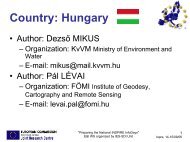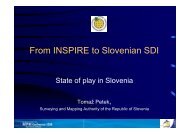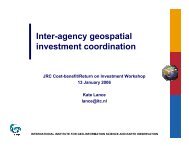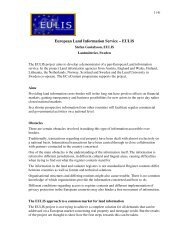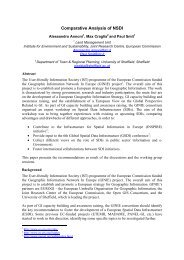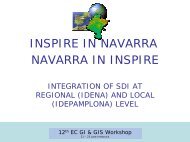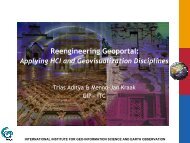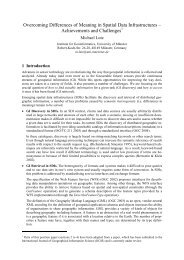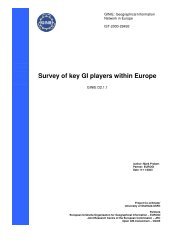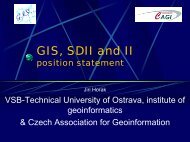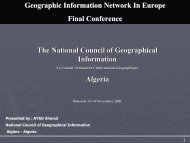session - EC GI & GIS Portal
session - EC GI & GIS Portal
session - EC GI & GIS Portal
Create successful ePaper yourself
Turn your PDF publications into a flip-book with our unique Google optimized e-Paper software.
SESSION METADATA AND CATALOGUES<br />
Schema translation<br />
Establishing, documenting and publishing a vocabulary by means of an application schema is an important<br />
step. Still, it should be clear that there will be a more or less complex gap between the internal schema of an<br />
application and the published schema that needs to be bridged. Since re-engineering of the applications to align<br />
the internal schema with the published schema is usually not an option, because it would be too expensive or<br />
simply inappropriate, technologies providing such a bridge are required.<br />
To describe such a capability, the term of a translating Web Feature Service (WFS-X) has been coined by<br />
OGC. A WFS-X enables the providers of content to configure a mapping from a published to an internal<br />
schema. The emphasis here is on configuration instead of hardcoding the mapping in software.<br />
This approach has, for example, been explored in several OGC initiatives [6, 7] using different technologies to<br />
describe the mapping including XSLT- and XQuery-based approaches.<br />
Interactive instruments has developed rules for a mapping from a GML Application Schema to SQL databases<br />
and implemented these rules in their XtraServer product. The mapping rules are specified as part of the GML<br />
Application Schema documents in XML Schema annotations, or in a separate configuration file,<br />
and is based on Xpath expressions. The mapping allows to encode rather complex mappings from the<br />
published schema to the internal database schema.<br />
The mapping takes into account:<br />
� the encoding of the database contents in XML (GML) according to the published application schema<br />
and vice versa;<br />
� an efficient encoding of queries that were formulated on the information model of the published<br />
application schema as SQL queries acting on the internal database schema.<br />
The paper will describe the approach, provide examples and discuss limits of such approaches based on our<br />
experiences.<br />
The technologies discussed in this paper are a promising approach to leverage existing datasets into the<br />
emerging infrastructures for geospatial services and data. In particular the topic of automatic translation<br />
between different schemas will require further research – and testing using real-world test cases from different<br />
application domains.<br />
References:<br />
[1] ISO/TS 19103 (http://www.iso.ch/)<br />
[2] ISO 19109 (http://www.iso.ch/)<br />
[3] GML 3.2.0 = ISO/DIS 19136 (http://www.iso.ch/)<br />
[4] ShapeChange (UML to GML Application Schema conversion tool, http://www.interactiveinstruments.de/ShapeChange)<br />
[5] OWS-2 Application Schema Development (http://portal.opengeospatial.org/files/?artifact_id=8071)<br />
[6] OGC CIPI 1.2 initiative (http://www.opengeospatial.org/initiatives/?iid=64)<br />
[7] OGC GOS-TP initiative (http://www.opengeospatial.org/initiatives/?iid=8)<br />
[8] GeoInfoDok of the German AFIS-ALKIS-ATKIS project<br />
(http://www.adv-online.de/exteng/broker.jsp?uMen=01a700d3-6ed6-0bfb-8f23-50376a112976)<br />
[9] OWS-3 Schema Tailoring and Maintenance (to be published as an OGC Discussion Paper)<br />
[10] OGC Catalogue Services – ebRIM (ISO/TS 15000-3) profile of CSW<br />
(http://portal.opengeospatial.org/files/?artifact_id=7048)<br />
28



